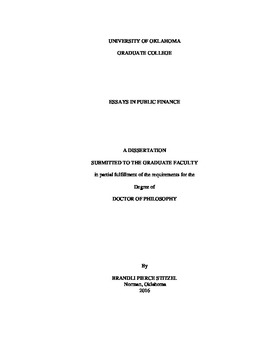| dc.description.abstract | Chapter one presents a novel approach for analyzing spatially differentiated impacts of a variety of large, geographically anchored entertainment attractions, including professional sports venues, convention centers, destination retail, and mega-events. Public investments in such projects are often justified based on the potential to stimulate economic growth. The literature, however, fails to substantiate the existence of net aggregate benefits which are typically evaluated at the MSA level. I extend the literature by developing a spatial panel estimation approach which considers differential impacts across geographic locations as well as industry types. I demonstrate the method by investigating the relocation of the National Basketball Association Seattle team (Supersonics) to Oklahoma City (OKC Thunder). The franchise impacts are measured in terms of establishment-level sales using a unique micro dataset, the National Establishment Times series (NETs). The results highlight spatially differentiated impacts across the metro area: the franchise relocation attracted retail sales to the downtown area of OKC but may have decreased sales outside of downtown.
Chapter two designs and implements a field experiment in Norman, Oklahoma to analyze the effect of norm-based messages on residential water use. The analysis finds evidence that the conservation message and the peer comparison messages encourage water conservation. The estimated response to receiving a social comparison message is a 5 to 8.7% reduction in monthly water consumption. I find notable heterogeneity in response to social messages. Customers who consume more water than the median water utility user respond more to social messages than those who use less than median. The findings suggest that social messages can be a cost effective option for municipalities looking to reduce residential water use through non-pecuniary mechanisms.
Chapter three investigates approaches for estimating water demand and responses to water rate changes. Water utility pricing generally involves different rates for different levels of consumption. Such block rate structures complicate demand estimation. I challenge the long standing implicit assumption that a city’s demand can be represented by a single city-wide (or region-wide) demand curve in the presence of rate block pricing schemes. We employ the longest and most detailed panel dataset of household level water consumption, weather records, and housing characteristics available in empirical studies. This allows us to estimate demand curves for separate user groups in an increasing block rate scheme. We analyze two water utility rate changes implemented in Norman, Oklahoma and find downward sloping demand curves in all but one case. I estimate price elasticity to be between -0.13 and -0.53. Our estimates suggest that, in general, the more water a customer consumes, the more price sensitive she is. | en_US |
